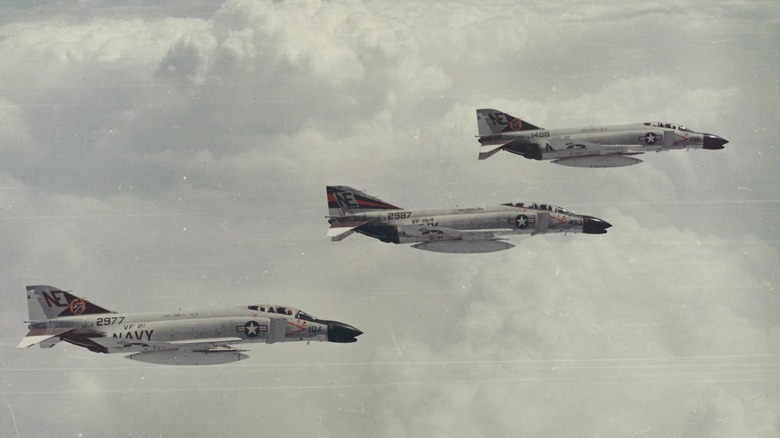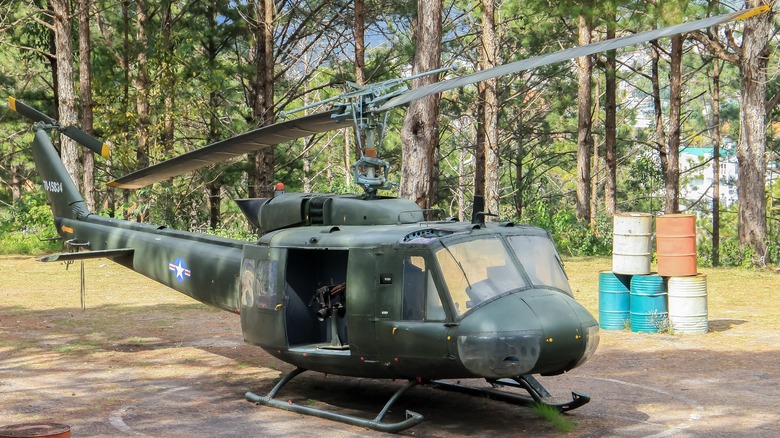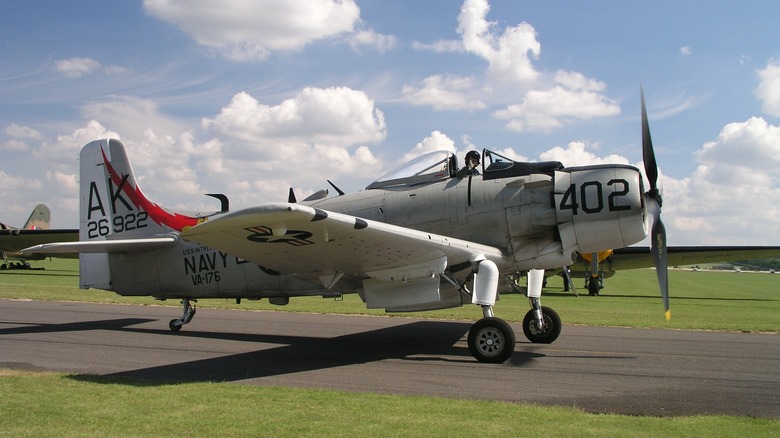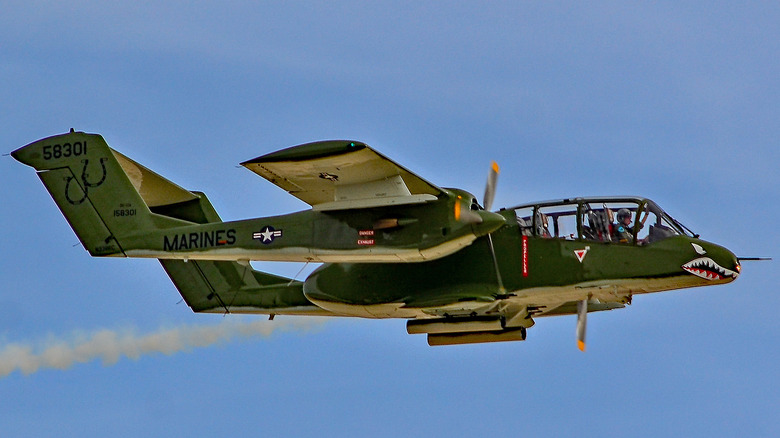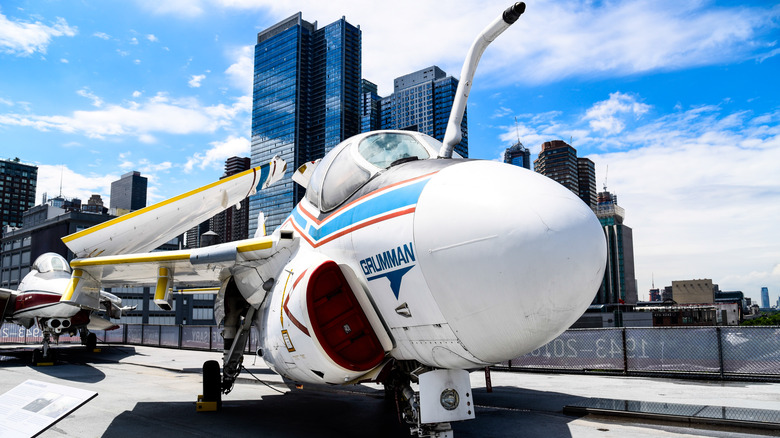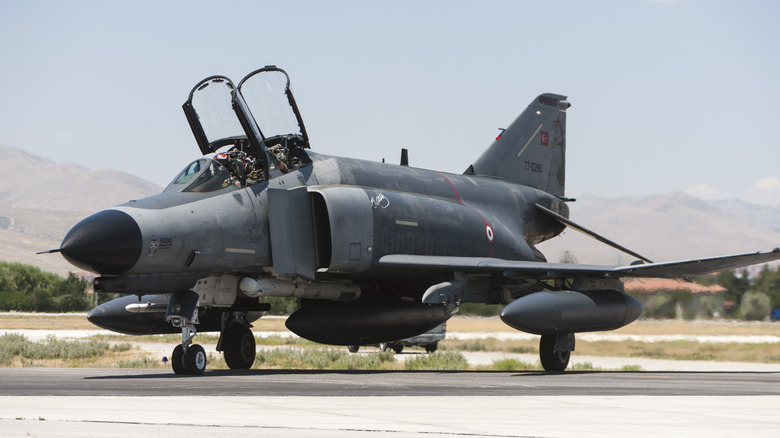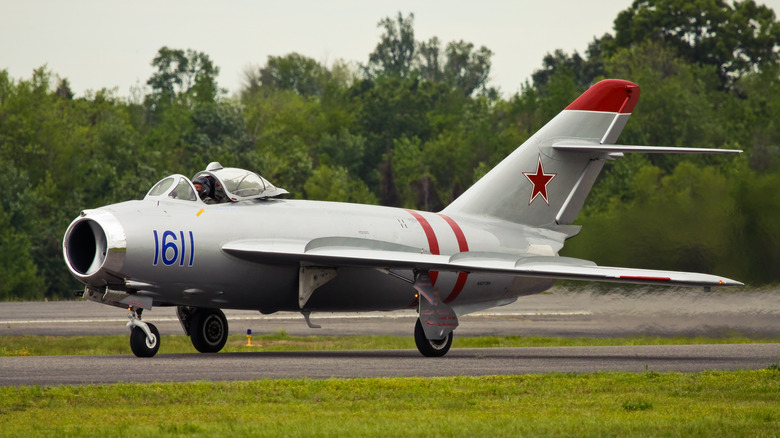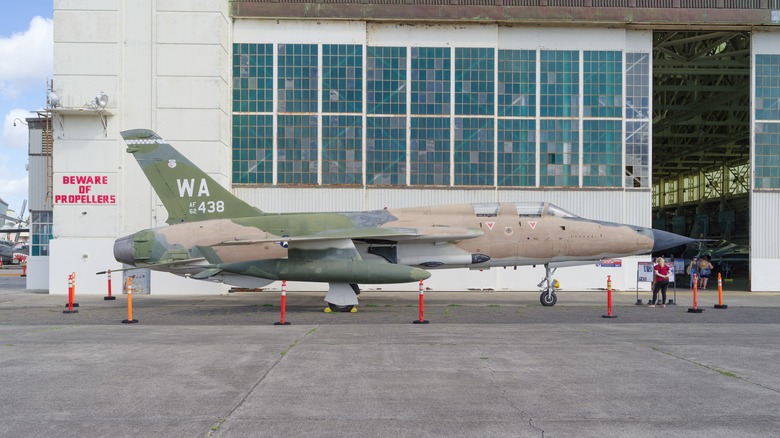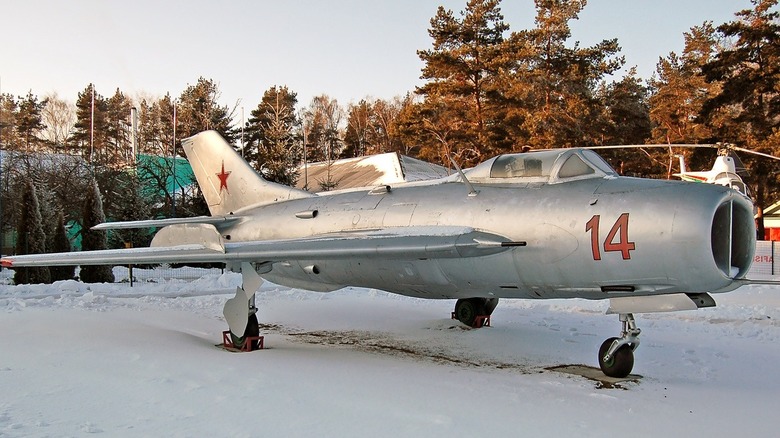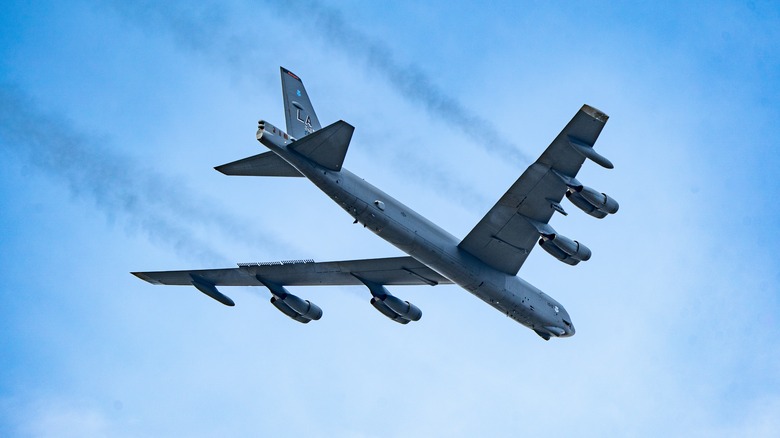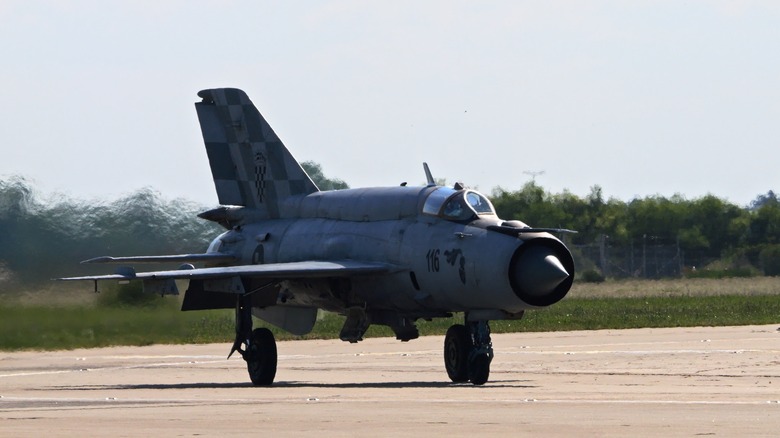10 Of The Most Notable Aircraft To Fly In The Vietnam War
The Cold War coincided almost perfectly with the rise of the jet age. In the denouement of World War II, American and Soviet forces scrambled to secure jet engine technology developed by German scientists.
In the early 1950s, the United States and the USSR tested the new technology in clashes over the skies of Korea in places like MiG Alley. However, Vietnam, another piece on the Cold War chessboard, would be entirely different. In the 20 years after the Korean War, Vietnam's jungle terrain posed new and unique challenges to military aviation.
In 1962, Secretary of Defense Robert McNamara tasked Lt. Gen. Hamilton Howze with incorporating helicopters into the American army. The Howze board pioneered the idea of air mobility — inserting infantry via helicopter — as a way to combat North Vietnamese regulars and Viet Minh guerillas operating in the thick jungle environment.
Though initially set aside, the air mobility strategy eventually emerged as the predominant method of waging war in Vietnam. Images of helicopters disgorging troops in rice paddies and Creedence Clearwater Revival's Fortunate Son set against the backdrop of fleets of Huey helicopters would come to define an era of American military aviation.
It wasn't just the helicopters. In the bid for victory, the United States and USSR would throw the latest and greatest in their military aviation arsenals into the fray. Everything from the MiG-21 to the B-52 Stratofortress met in the skies for supremacy over Southeast Asia. Let's explore some of the most notable aircraft that flew in the Vietnam War.
Bell UH-1 Iroquois (Huey)
The Bell UH-1 Iroquois, more than any other aircraft, became the face of the Vietnam War. The UH-1 first flew in 1956 as the XH-40. Later, the Army redesignated it as an HU-1, which was the source of its affectionate nickname: the Huey.
Developed by the Bell Aircraft Corporation, the Huey was the first helicopter to ditch piston engines in favor of a jet turbine powerplant. Since its inception, the airframe has collected millions of flight hours and continues to fly today.
Of the 16,000 Hueys built by Bell between 1955 and 1976, more than 7,000 made it to Vietnam beginning in April 1962. Army medical units first used it to ferry wounded and supplies around the war zone. As the war escalated, the United States poured more men and materials into Vietnam. The Marine Corps adopted its use in 1965, and the Air Force and Navy followed suit. By 1966, Hueys became the face of the war.
The Huey was powered by a 1,400 shaft horsepower (shp) Lycoming T56-L-13 turboshaft engine. It could travel at a max speed of 148 mph (238 kph) and cruise at 127 mph (204 kph). Operated by a crew of at least two, the pilot and co-pilot were often supplemented by one or more crewmen operating M60 machine guns. It could accommodate 12 to 15 troops or six stretchers.
The Huey was a key component of the air mobility strategy. It was versatile; it could insert and pick up troops, transport material, and even serve as a weapons platform.
Douglas A-1 Skyraider
Though mired squarely in the jet age (the jets are coming, we promise). The war in Vietnam served as the piston aircraft's last great campaign. The Douglas A-1 Skyraider may not have the name recognition of the P-47 Thunderbolt, but it saw plenty of action as a ground attack platform in Vietnam.
The Skyraider was one of the last heavy piston-engined attack planes. Douglas produced the first one in 1945 and built 3,180 by 1957. Measuring 50 feet (15 meters) with a wingspan of 39 feet (12 meters), the Skyraider had an empty weight of 10,470 pounds (4,750 kilograms). Equipping fifteen hardpoint weapon mounts, the Skyraider could carry up to 12 rockets, 7,000 pounds (3,175 kilograms) of bombs, and four 20-millimeter cannons.
A Wright R-3350-24W air-cooled radial engine gave it a max speed of just 321 mph (517 kph) — relatively slow compared to the top World War II fighters. Its low speed, coupled with a 10-plus hour flight time and a range of 1,553 miles (2,500 kilometers), made it an excellent ground support aircraft. Vietnam measures about 1,000 (1,600 kilometers) miles from north to south, meaning Skyraiders could support missions all over the battleground.
Skyraiders often took on escort duties, providing ground attack capabilities in support of missions to rescue downed pilots. They also served as defensive measures against besieged or embattled outposts. Pilots and troops came to appreciate the Skyraiders' durability and ground-attack capabilities, knowing that one being on station overhead significantly improved the situation.
North American Rockwell OV-10 Bronco
The Skyraider wasn't the only propeller plane to see action in Vietnam. Not all missions call for jet strikes or heavy ground pounders. An unusual and aesthetically interesting aircraft, the North American Rockwell OV-10 Bronco found a niche in combat as a forward observer and light attack aircraft.
Unlike the Skyraider and Huey, the OV-10 was not developed until 1966, when the Vietnam War was heating up. It was powered by twin Garrett-AiResearch T76 turboprop engines making 715 shp each. The Bronco was classified as a short takeoff and landing aircraft good for getting in and out of runways with restricted space. It had a cruising speed of 223 mph (359 kph), a maximum speed of 281 mph (452 kph), and a range of 1,240 miles (1,995 kilometers).
The Bronco arrived in Vietnam in 1968. Crewed by a pilot and co-pilot, a rear compartment could accommodate up to 3,200 pounds (1,451 kilograms) and had room for two stretchers or five combat troops inside, though it was used primarily for observation. The Bronco nonetheless came with some sting in the form of four M-60 7.62-millimeter machine guns. During its time in Vietnam, it served nearly every role for which it was designed: observation, forward air control, surveillance, helicopter escort, and light ground attack.
Seven Broncos were lost during the Vietnam War. The Bronco continued to serve in the Marine Corps, seeing action in Operation Desert Storm before retiring in 1995.
[Featured image by Tomas del Coro via Wikimedia Commons | Cropped and scaled | CC BY-SA 2.0]
Grumman A-6 Intruder
Twenty years earlier, the Korean War exposed the United States Navy's need for a long-range, high-subsonic strike aircraft. Grumman delivered the A-6 Intruder, an example of the rise of Cold War jet technology. Sophisticated and designed to penetrate enemy defenses at low altitudes, Grumman delivered the first Intruder to the Navy in 1963. The Maine Corps got them in 1964.
The Intruder was the first all-weather attack bomber that could detect and destroy targets with conventional and nuclear weapons in low to zero visibility. Equipped with electronic sensors and countermeasures, the carrier-based bomber could identify and attack tactical targets with a wide array of weapons. Extremely versatile, it could carry up to 18,000 pounds (8,164 kilograms) worth of more than 30 types of armament.
The Intruder was 55 feet long with a wingspan of 53 feet. Its maximum catapult-assisted weight was 58,600 pounds, its cruise speed was 647 mph, and its ceiling was 42,400 feet. Crewed by a pilot and co-pilot in a side-by-side position, it arrived in Vietnam in 1965. Prior to its debut, military aviation relied heavily on clear weather to launch missions. The all-weather A-6 shifted this capability, allowing the Navy and Marines to launch attacks in inclement weather.
Due to its relatively low speed for a jet bomber, the Intruder proved vulnerable to anti-aircraft defenses. The military lost 78 A-6s in combat, and another 11 were destroyed under non-combat conditions.
McDonnell Douglas F-4 Phantom II
Up there with the Huey as an icon of Vietnam, the McDonnell Douglas F-4 Phantom II was the most prolific aircraft of the war. Designed by the Navy as a state-of-the-art fighter-interceptor, the U.S. Air Force and Marine Corps took it on for its air-to-air capabilities. Equipped with two General Electric J-79-GE-15 jet engines creating 17,000 pounds of thrust each, the supersonic Phantom could reach Mach 2 flight with a maximum speed of 1,400 mph (2,253 kph). Its cruising speed was a more sedated 590 mph (950 kph).
The Phantom debuted in Vietnam in 1964 with the task of destroying the Soviet-supplied North Vietnamese air forces equipped with MiGs. It was an opportunity to see how the rival nations' weapons development systems stacked up.
Early Phantoms came without a nose-mounted gun, leaving it purely with missiles as weapons. Phantoms were responsible for the first aerial kills of the war in June 1965. But the grab-them-by-the-belt strategy employed by the enemy on the ground translated into the sky. Dogfights were often too close for missiles, so the military equipped the Phantom with 20-millimeter M61 Vulcan cannons for short-range dogfighting.
The Phantoms could also ground attack with rockets and bombs, some equipped with the hellacious napalm jelly that burned everything in its path. However, they paid a stiff price in Vietnam; the military lost a total of 689 Phantoms to combat and accidents.
Mikoyan-Gurevich MiG-17
As the career of the Phantom attests, an aerial enemy patrolled the skies over Vietnam. The Soviet Union supplied North Vietnam with aircraft and trainers to fight American air superiority. The Mikoyan-Gurevich MiG-17 was one of the Soviet aircraft thrust into the theater.
By the time the Vietnam War rolled around, the MiG-17 was practically an antique, which is possibly why the Soviet Union felt comfortable shoveling it off to North Vietnam. With its first flight in January 1950, it was not precisely state-of-the-art when it arrived in Vietnam in 1964. However, the Soviets upgraded it over time, producing five variants.
The North Vietnamese Air Force (NVAF) organized the 921st Fighter Regiment in early 1964. A combined dogfighter and attack plane, the MiG employed a Klimov VK-1F engine making 7,452 pounds of thrust, pushing the airframe to a max speed of 711 mph (1,144 kph). It carried one 37-millimeter cannon and a pair of 23-millimeter cannons and could load 16 rockets and 1,100 pounds (500 kilograms) of bombs.
Chinese and Vietnamese pilots utilized the MiG-17 primarily as a day fighter. At a maximum weight of 13,380 pounds (6,070 kilograms), it was lighter than many of its American foes and could outrun some of them. The U.S. Navy established the Top Gun program in 1969 partly as a response to the toll incurred by MiGs in Vietnam.
Republic F-105 Thunderchief
The MiG-17 wasn't the only aircraft developed in the early 1950s to fly in Vietnam. Republic Aviation's F-105 Thunderchief emerged as a supersonic fighter bomber meant to replace the F-84F Thunderstreak. The Thunderchief prototype, the YF-105A, underwent its inaugural flight in October 1955, but the F-105D that would fight in Vietnam did not show up until June 1959.
Deployed shortly after the Gulf of Tonkin incident that kicked off full-scale hostilities, the Thunderchief was a prominent player in the Rolling Thunder bombing campaign that aimed to cripple North Vietnam's resolve to fight between February 1965 and October 1968.
Powered by a single Pratt & Whitney J75-P-19W making 26,500 pounds of thrust, the Thunderchief could carry 12,000 pounds (5,443 kilograms) of ordnance. It also employed a single 20-millimeter M61 Vulcan gun. Thunderchiefs were primarily tasked with ground attack. Its primary mission was low-level nuclear strikes, but the airframe claimed a trio of MiG kills between 1967 and 1970.
The Thunderchief is perhaps most famous for its duty as a "Wild Weasel." Wild Weasels aircraft had specialized crew and equipment to attack the surface-to-air missile (SAM) sites that were taking a toll on American military aircraft. The task was perilous. A two-man aircrew would take an F-105 Wild Weasel (typically armed with anti-radar missiles and a full load of bombs or rockets), on strike missions to disable enemy air defenses.
Mikoyan-Gurevich MiG-19
The North Vietnamese also operated MiG-19 jets during the air war. Slightly newer than the MiG-17, the MiG-19 entered production in 1955 as the Soviet Union's first fighter capable of attaining level supersonic flight and the world's first operational supersonic jet fighter.
The speedy MiG was primarily a high-altitude dogfighter. Powered by a pair of Tumansky RD-9 turbojets making a combined 14,000 thrust, it could reach 903 mph (1,453 kph). Similar to the F-4, early iterations lacked guns in favor of missiles, but by the Vietnam era, the powers that be corrected that oversight, eventually equipping it with three NR-30 30-millimeter cannons.
Though outclassed in short order by the MiG-21, the Soviet Union and its Warsaw Pact member states nonetheless built around 10,000 MiG-19s, and it was just as well that there were so many; during the Vietnam War American forces claimed 197 MiG-19s shot down, including the first American aerial kills of the war when F-4 Phantom IIs shot down two in June 1965.
[Featured image by parfait via Wikimedia Commons | Cropped and scaled | CC BY-SA 3.0]
Boeing B-52 Stratofortress
Designed for global-scale conflict, the B-52 Stratofortress was a heavy bomber designed to spread hate at near supersonic speed thanks to its payload of more than a hundred 500-pound bombs. Following the post-World War II B-36 Peacemaker, the B-52 would be a critical component of Cold War nuclear brinksmanship.
The B-52 is an enormous aircraft. Measuring 159 feet (49 meters) with a wingspan of 185 feet (56 meters), it had a maximum takeoff weight of 185,000 pounds (83,250 kilograms) and a payload of up to 70,000 pounds (31,500 kilograms). An incredible eight Pratt & Whitney TF33-P-3/103 turbofan engines made up to 17,000 pounds of thrust each, which helps explain how the B-52 could achieve altitudes of over 50,000 feet (15,240 meters) and up to 650 mph (1,046 kph).
The B-52 was more than just a military aircraft. President Richard Nixon used the heavy bomber as a political chip in the infamous "Christmas Bombings." Determined to pull the North Vietnamese back to the negotiation table in Paris in 1972, Nixon deployed over 200 B-52s on an eleven-day bombing campaign named Operation Linebacker II. The bombers attacked deep into North Vietnam, hitting targets in Hanoi, Haiphong, and other locations.
The B-52 could fly high and fast, but despite efforts to protect them, they still incurred losses. Over 30 aircraft were destroyed during the war, 17 in combat, and an additional 14 to other causes.
Mikoyan-Gurevich MiG-21
The most advanced Soviet fighter to see service in Vietnam was the MiG-21. Dangerous as a dogfighter and force-interdiction flyers, the Soviet Union produced more than 10,000 of the respected fighters, which didn't cease production until 1985.
One reason for the longevity of the Fishbed, as NATO ignominiously nicknamed the MiG-21, was that the Soviet aviation industry learned significant lessons from the swept-wing design of the MiG-17 and MiG-19. Adopting a "tailed delta" configuration with a thin wing, the MiG–21 proved maneuverable and fast, with a top speed of 1,300 mph via a pair of Tumansky R-11F2-300 engines. With radar-guided and heat-seeking missiles, a range of 870 miles, and an operational ceiling of 62,000 feet, it was a modern fighter that would have a long career.
The MiG-21 proved a worthy match for the F-4 Phantom when it entered the war in June 1966. The North Vietnamese air force would monitor bombing attacks, sending MiGs into the fray when bombers were low on fuel and full of payloads to make zooming high-speed attacks against the formations.
The American advantage in technology and numbers was mitigated because the MiGs primarily operated over friendly territory loaded with anti-aircraft emplacements. The MiG-21 proved a competent craft, participating in many conflicts in the latter half of the 20th century. Heck, the MiG-21 flying coffin is still in service today.
